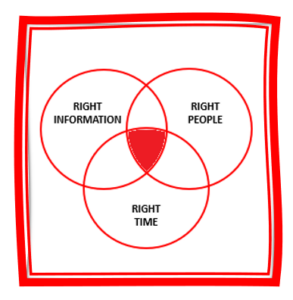It has become cliché to say we are living in difficult times. No sector has been left unaffected by the pandemic; add to it the worsening of the climate crisis and the failure of the current neoliberal world order, the future has become far more uncertain. Every sector has had to adapt, be agile, and change at an accelerated rate to stay relevant. The NGO/non-profit sector is no different.

Srividya Harish, Action Aid
The sector is trying to map trends and is looking for solutions. I propose that investing in knowledge management (KM) is one such solution that can help NGOs overcome challenges and deepen impact.
What is KM? A google search will turn up many definitions. For example, “Knowledge Management is the process of creating, sharing, using and managing the knowledge and information of an organization.” Simply put, KM is the art and science of delivering the right knowledge to the right people at the right time. How does this help meet the challenges then?
Let’s take a closer look at some of the challenges facing the sector today, keeping in mind that every challenge can also present an opportunity.

Srividya Harish, Action Aid
Localization – As the debate around the decolonization of aid heats up, there is more of a push to adopt localization as a principle rather than just a commitment for humanitarian assistance under the Grand Bargain. While this is a necessary shift, it challenges both INGOs and local NGOs to adapt to show the value added and ensure sustainability.
Increased compliance requirements – In their report on “Trends in cross-sector partnering for INGOs,” BOND and The Partnering Initiative (TPI) noted, “INGOs face increasingly stringent regulatory frameworks for financial management, reporting, and safeguarding, which they are in turn passing downstream. This can make it difficult to work with small local partners, who may lack the capacity to comply. Instead, some INGOs and NGOs are having to work with larger ones, which can meet the requirements.”
Shrinking political and civic space – Discussing this topic in their research, Felix S. Bethke and Jonas Wolff explain, “COVID-19 has given a substantial boost to a global trend that has been unfolding since the early 2000s: the shrinking of civic spaces, which is characterized by an increase in government restrictions that target civil society actors and limit their freedoms of assembly, association, and expression.”
Consortia and multi-stakeholder partnerships – As discussed by BOND and TPI, “Donors are increasingly adopting the formal consortium model. The complexity of the issues facing society today and the level of challenges necessitate new and larger alliances.” This means that there will be trade-offs that need to be negotiated and managed.
Changing donor landscape – The donor landscape has perhaps irrevocably changed, with declining unrestricted income, more dependence on institutional donors, and changes in how “aid” is viewed by both the giver and the receiver. Furthermore, millennials entering the giving scene, corporate giving, new fundraising models like membership-based organizations, impact investing, donor-advised funds, outcome buying, social entrepreneurship, etc., mean that there are challenges and opportunities at every level.
Digital transformation – Rapid technological advancements have meant that more can be done in terms of reach and scale. It also means that the NGO sector is challenged to use the technology ethically and keep up with the rapid changes and find concrete ways to bridge the digital divide.
While 2020 brought quick and unexpected changes, becoming more flexible is always a good strategy. How can one pursue a mission, even in the face of significant changes? KM and its intended result—continuous learning—is one solution that will help organisations be more adaptive and agile as they respond to these challenges and more.

Knowledge Management Cycle based on Meyer and Zack model
simplest model of managing knowledge is the KM cycle. Set up systems and processes to create new knowledge, identify and capture knowledge, curate it, store it appropriately, create platforms to share, and give opportunities for application and use. Measure the application, identify gaps, and that leads to new knowledge generation. Sounds simple right?
Here are some examples of how KM can help mitigate challenges to deepen the programmatic impact.
1. Generate evidence and alternatives through research and documentation. This helps in:
a. Fundraising – Donors are no longer wowed by “people reached” and “human stories,” and as explained by Milos Maricic, “They are beginning to ask difficult questions. What is your theory of change? How do your actions practically address the systemic problems?” Having the evidence ready means that your partnership with donors remains strong, enabling new funding avenues to open up.
b. Accountability – As NGOs, our primary accountability lies with the communities we work with and for. Having robust evidence means that we can represent the people we work with and amplify their voices in relevant spaces.
c. Public engagement – Engaging a large-scale audience and gaining support requires more than merely criticizing the current models and systems. For disruption to happen, you need to give credible alternatives. Effective KM can help generate alternative models.
2. Knowledge management as a service – The way forward for all NGOs is to partner with people-led movements. One way to partner with movements is to lend the infrastructure of NGOs to the right causes by offering to manage knowledge, especially generating new knowledge, and sharing it, aiding the cause.
3. Improve efficiency – KM principles can be used to co-create and collaborate. Today knowledge is no longer power; it is the sharing of knowledge and learning that is powerful. This will build trust among multiple partners in a consortium or network. Shared ownership of evidence and learnings that contribute to decision-making also means fewer transaction costs.
4. Credibility and accountability – Having access to real-time data, generating good quality reporting to communicate progress, demonstrating value for money through data and evidence means that you remain credible and a trustworthy partner. It also means that you deliver on accountability to the people in whose name you fundraise.
5. Ethical use of IT – KM of today has a big “systems” component. Instead of having technology-driven solutions, putting people at the center of digital, and then choosing technology to support the cause of the people—be it staff or the communities we work—it requires thinking on the KM lines. This includes personal data protection, bridging the digital divide, etc.
6. Investing in people – KM should lead to learning and capacity strengthening. It means that we invest in our people to acquire the right knowledge when needed, learn from it, use it, and be aided by other learning methodologies perform for both an organisation’s and personal growth.
KM can help in various ways. It is not a magic wand that will address all the challenges—that requires more of a system change—but investment in good KM for your organisation can certainly help mitigate many of the challenges you face today.
References

